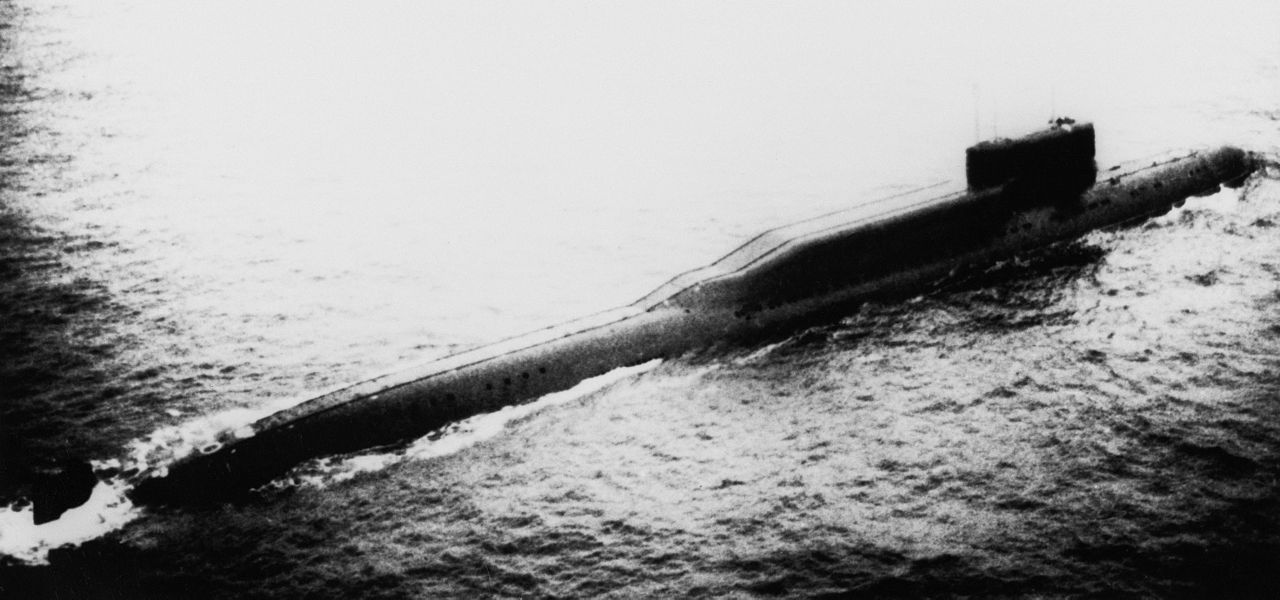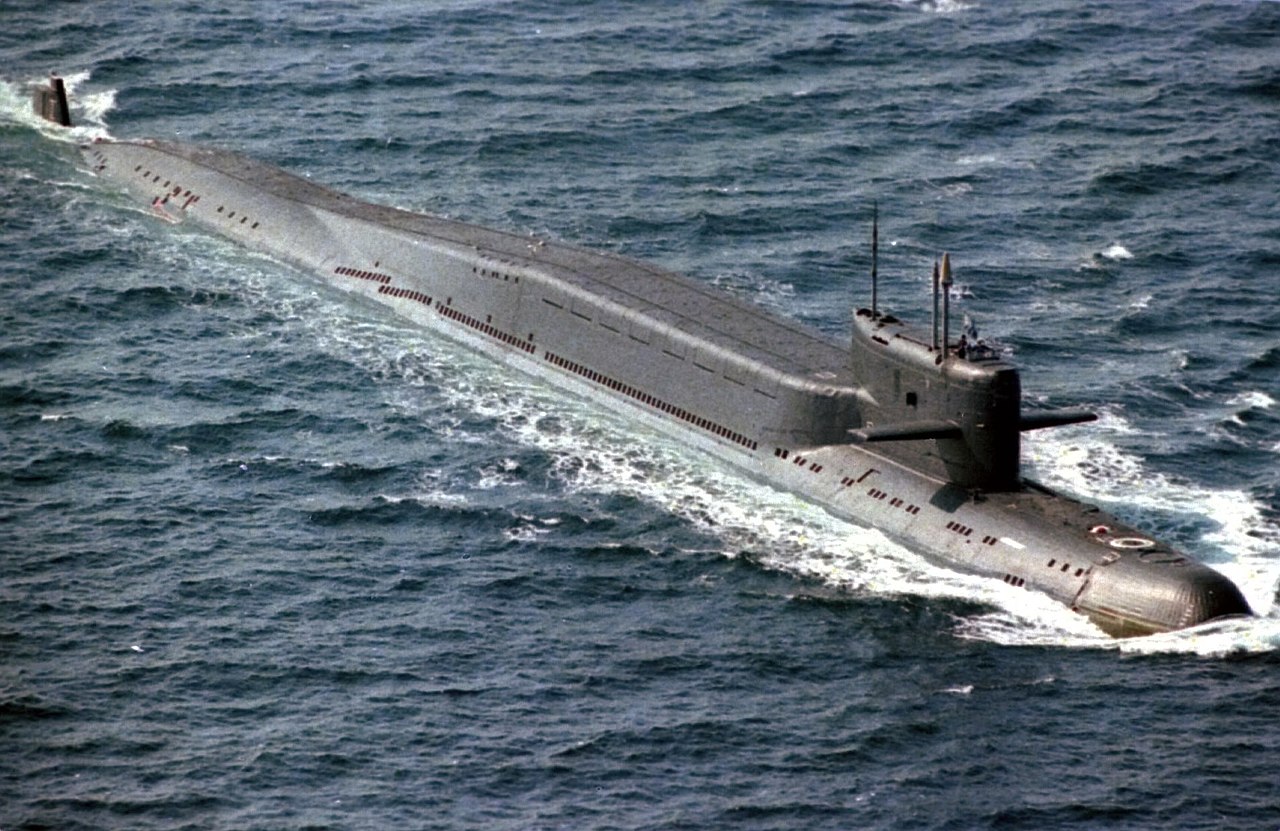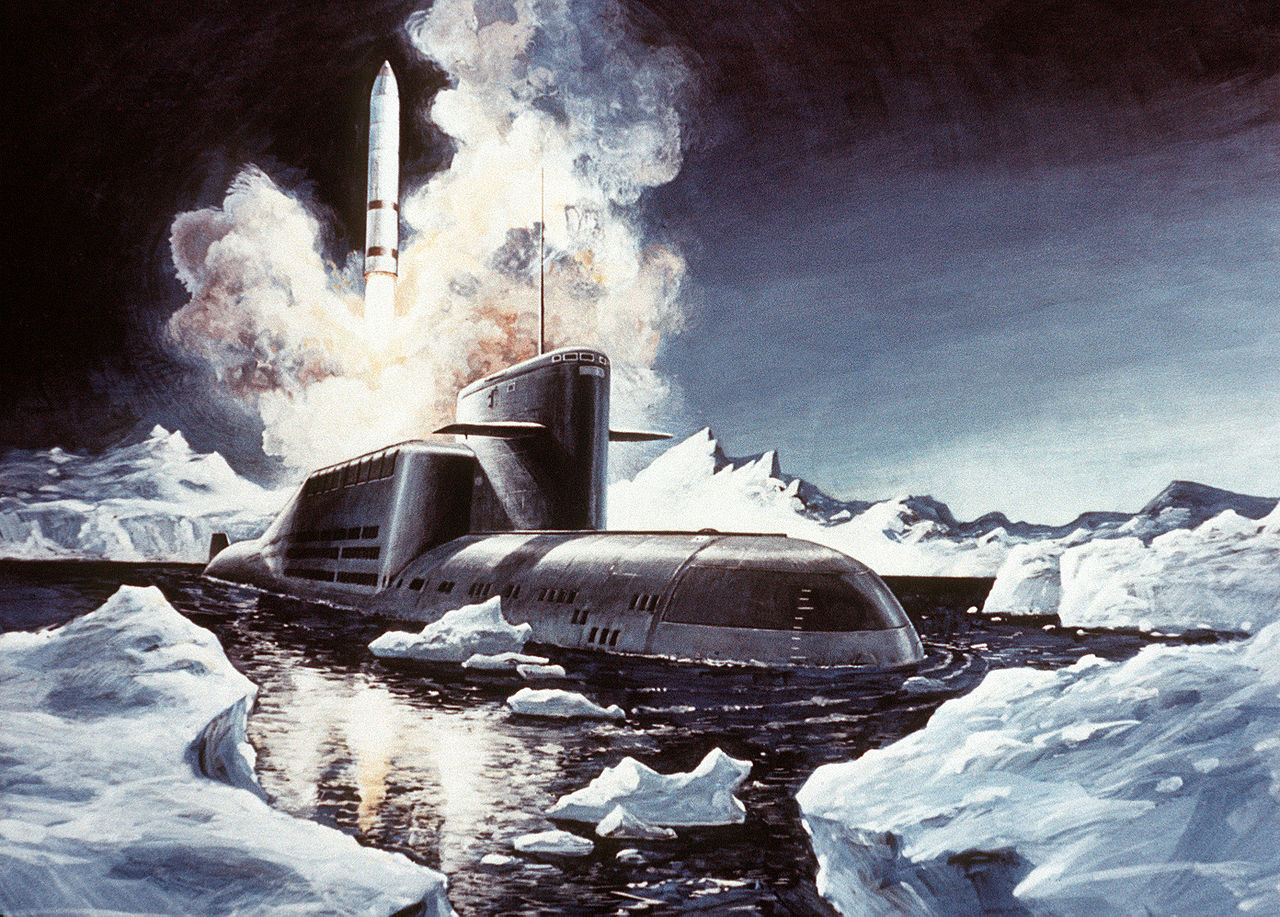The Soviet Union first began to send strategic ballistic missiles to sea in the early 70s, and while they were reasonably happy with the resulting Yankee class, it did have one major drawback. The R-27 missiles it carried were relatively short-ranged, forcing the boats to patrol in the open ocean within easy reach of American ASW forces. Besides the risk of the USN killing the SSBNs before they could fire, there was also the issue that only a small fraction of the force could be on station at any one time. The USN had gotten around this problem by having two crews for each boat and forward-basing them at the ports of its allies, but the Soviets had enough trouble manning their fleet as it was, and didn't have any equivalent bases.

Delta I on the surface
The obvious solution was to build a longer-ranged missile, which emerged in the form of the R-29 (NATO SS-N-8), twice the size of the R-27 and with a range of about 4,200 nm, enough to let it target the entire US from pierside, if necessary. Now, instead of having to reach the Atlantic, the SSBNs could be kept close to the Soviet Union, where other air and naval forces could easily be deployed to protect them.

R-29 missile
The new missile was first tested out on two older SSBNs, a Hotel and a Golf, and then deployed en masse using a stretched version of the Yankee, designated by NATO as Delta I. Each carried a dozen R-29s, and a total of 18 were built, with the Soviet SSBN force surpassing that of the USN in raw numbers in 1974, although the Americans retained an edge in accuracy and warhead numbers thanks to Poseidon. Two years earlier, the two superpowers had signed SALT I, which capped the inventory of intercontinental missiles for both sides, no matter where they were deployed. The US would be limited to 44 SSBNs with a total of 710 missiles, while the Soviets could build to 62 SSNBs and 950 missiles, although any increase past 740 missiles would require other launchers to be dismantled. The Soviet cap was set high enough that this agreement, the first international limitation on warship numbers since the 1930 London Treaty, did little to slow their massive SSBN program, which averaged 5.5 boats a year from 1967 to 1977.

A Delta II
The first follow-on to the Delta I was the 4-boat Delta II class, which were merely stretched again to accommodate 16 R-29 missiles, along with various detail improvements, such as better quieting. But this was merely a stop-gap while an improved version of the R-29, designated R-29R (SS-N-18), was being developed. This brought MIRVs to the Soviet submarine fleet, with the capability to carry up to 7 warheads, although at a significant cost in range. 16 would be carried by the Delta III, a further evolution of the basic Delta configuration. Besides the standard detail improvements over the Delta II, the Delta III also introduced a special smoking room, a first onboard a submarine, and the ability to fire all of its missiles in less than a minute, instead of the spread salvoes of early Soviet SSBNs. A total of 14 were built from 1976 to 1982, with the later units presumably being compensated for under SALT by the retirement of the early Yankees to SSN or SSGN roles.

DIA sketch of a Soviet SSBN base
The Deltas marked the point when a significant fraction of Soviet nuclear firepower moved to sea, as the Soviets found a way of operating SSBNs that meshed with their political and operational needs. Because the new missiles could be fired from pierside (a capability tested in the mid-70s), the boats could spend most of their time in port, under the watchful eye of the Soviet security services. This was important to the paranoid leadership of the USSR, who had nightmares about a boomer captain on patrol doing something insane, like trying to defect to the US. If a crisis threatened, the majority of boats would be ready to go to sea on short notice, enhancing the survivability of the Soviet deterrent.

A Delta III breaks the ice to fire its missiles
Equally important was the environment that the new boats would operate in. Instead of trying to hide alone in the open ocean, as the Americans did, they would be protected in Arctic "bastions", guarded by the ships, aircraft, and submarines of the Soviet Navy. Tactics included hiding under the ice, which wreaks havok on sonar, and surfacing to fire their missiles. A few tests were even apparently conducted with firing through the ice while submerged, or while the submarine sat on the bottom. The Soviets were particularly paranoid about the safety of their SSBNs because they believed that it was possible for any war with the West to be limited, with the outcome determined by who had more nuclear firepower remaining at the end. Ultimately, this particular theory would actually be turned to NATO's advantage in the 1980s, when the USN began to plan for an offensive against the Soviet's northern flank, ultimately exposing the Soviet's inability to face them down.

Delta III
During the late 60s and 70s, the Soviets also experimented with using SLBMs in the anti-ship role. Golfs and Hotels frequently operated in area that the US carriers would have to pass through on their way to Europe, prompting speculation that they were to use their missiles in the anti-ship role. However, the lack of guidance systems meant that any hit would likely be via blind luck, and the Soviets began development of a version of a specialized anti-ship version of the R-27, the R-27K/SS-NX-13. This used a shortened version of the R-27 to boost a second stage containing a passive radar seeker and a restartable engine on a rough trajectory. The radar antenna would unfold and detect the target, and the engine would then place the entire thing on the correct trajectory.1 The shortened first stage gave it a range of around 400 nm, and in theory, the guidance system would be able to put the warhead within 400 yards of the target so long as it was within a footprint about 30 nm across. This was more than enough for the warhead, estimated at somewhere between 500 kT and 1 MT, to kill whatever it was aimed at.

A Golf modified to test the R-27K
Development went relatively well, with tests being run on a modified Golf, but there was still the extremely tricky problem of targeting. The Soviets looked at both passing data from nearby aircraft and at a satellite downlink, but before anything could be made operational, the program was killed off, a victim of SALT I. Any missile tubes dedicated to R-27Ks would come out of the allocation that could otherwise be pointed at land targets, and that had a higher priority. Instead, the world would have to wait another 40 years before an anti-ship ballistic missile was anywhere close to operational.2
But the R-27K was far from the only development program in work to improve the Soviet ballistic missile submarine force. The other programs would bear fruit in the 1980s, bringing solid fuel and the largest submarine ever built. We'll take a look at them next time.
1 Some sources claim that it was fitted with a maneuvering reentry vehicle, but the most comprehensive one I've found says otherwise. Given the technology of the time, and the relatively low accuracy that can be accepted when using nuclear warheads, I believe it was a non-maneuvering RV. ⇑
2 Apparently, the Soviets also looked at using ballistic missiles in an anti-submarine role, although no details are available, and the whole thing sounds insane. ⇑

Comments
When you say "smoking room", is that some weapon or engine term I am unfamiliar with or is that some sort of specially filtered room for the crew to smoke cigarettes? Prior to the room, could they just smoke anywhere they liked?
It was a room for smoking cigarettes. I'm not sure what the rules were before. I know on US boats, smoking wasn't banned until probably the 90s. I'd be surprised if the Soviets banned it entirely before the smoking rooms, but that's what my source says.
So, The whole navy has transitioned to Copenhagen or just the subs?
Copenhagen? Not sure what you're asking about.
Copenhagen as in the chew tobacco presumably
Ah. I was split between that being a typo and some reference to the naval battle that I couldn't parse.
To answer the original question, it appears that the USN didn't ban smoking on submarines until 2010, which is extremely surprising and 15 years later than I expected. That was apparently the last loophole in the 1994 indoor smoking ban, which suggests you can smoke on surface ships, but probably only in specific areas.
The Hindenburg had a smoking room.
Lined with asbestos for safety.
Apparently we underestimate just how universal it was, within living memory, for everyone to need a nicotine hit every hour or so.
While it's not really a naval topic, were road mobile missiles considered as an alternative to SSBNs? They seem like a natural solution for a country as big and empty as the Soviet Union, are easier to directly monitor for the KGB or whoever (defecting with one would be quite a challenge), and they are harder for the west's stronger navy to counter.
There was the RSD-10 road mobile IRBM and, in the final years of the USSR, the Topol ICBM. And then there's the RT-23 ICBM, which could be launched from a train.
Ah, so they didn't develop road mobile missiles with comparable range until years later, leaving only missile submarines (and trains) as a mobile deterrent.
The Soviet system was particularly bad at making those kind of decisions. Essentially, Brezhnev bought support by ensuring that nobody's ox was going to get gored, so there wasn't really a way to say "we don't need this thing any more, and we're stopping doing it". The subs got a constituency, and they weren't going to go away after that.
Bean, aren't you from Missouri? Pretty surprising you don't recognize a reference to Copenhagen.
I wonder if subs allow vaping onboard...
When it's mentioned as chewing tobacco, I recognize it. Chewing tobacco is more of a Missoura thing, and I'm not from that part of the state, so I defaulted to trying to figure out how this tied into a naval battle.
No clue about vaping.
IIRC (and it's been a WHILE) road- and rail-mobile launchers were heavily disfavored by various arms control treaties. Poking at Wikipedia it appears that the necessary tech to make them effective for anything other than citykilling came of age at the end of the Cold War, and they were therefore cut as unnecessary (in the US).
Road-mobile ICBMs more or less require you to either build a unique, mostly- or entirely-separate road network for your strategic rocket forces, or integrate the truck-launched missiles into normal traffic on existing roads. The former ends up functionally being a lot like a silo farm, except that you have to secure a much longer perimeter and a missile on a truck is a lot more difficult to harden against incoming fire than a missile in a silo. The latter is a security nightmare from the word go, and adds traffic accidents as a major source of risk to your ICBM force.
@bean That sort of 'we'll do both' reminds me a bit of Hitler's reputation for giving partial support to competing proposals, rather than committing to a choice. And on reflection, they both sound a bit similar to the standard 'concentrated benefits, diffuse costs' problem, where programs beneficiaries make them hard to cancel. It seems like a problem quite different forms of government may all succumb to.
@Philistine I would imagine that central Russia had less road traffic than much of the West, and while it would also have had fewer (and worse quality) roads, those big TELs can manage off road to a limited extent. The Strategic Rocket Forces would probably have been able to get away with closing roads at short notice, or otherwise inconveniencing other road users, in a way that wouldn't have been tolerated for long in the first world.
You make a good point about off-roading. It feels like it would work beautifully in Central Asia and be completely unworkable in the forest-belt. Maybe range considerations make it only useful against China.
Russian dashcam videos on youtube indicate that most of the missiles would be destroyed within a year or two.
And that includes Russian military. I've seen video of a tank losing control on what seemed to be ice, sliding onto a public road, and going straight over some private cars.
Nothing like an EOTW machine that smells like strawberry cupcake.
Yeah, if the rasputitsa makes your rural roads all but unusable for half the year, that would also be a pretty major flaw. I think the inability to build a road mobile missile that could reach the US is a sufficient explanation for opting for submarines initially, and once you have that force, bean's point about pressure from the SSBN lobby, and the various challenges of creating a road mobile force, make it hard to change direction. There is also the Soviet tendancy to want to match the US (e.g. Buran) so if the US is operating a submarine deterrent, the USSR will too.
On the subject of the difficulty of targeting road-mobile BM launchers, the lessons learned from GW1 are probably worth thinking about here (granted, smaller launchers, but also more open country, as well so it should balance out, I guess). Scud-hunting ended up being a mission that sucked up a lot of resources while producing very little (other than some really good military fiction from Andy McNab).
Re targeting, I suppose this depends on how accurate you need your initialization to be, but it seems like putting in enough survey markers or whatever would be relatively cheap and easy, even pre-satellite. Pull up to whatever the equivalent is of USGS survey marker, and you know your location close enough.
Obviously there is some additional risk from restricting the launch sites to only surveyed locations, but given the fact that they're already being surveyed for other purposes and are fairly omnipresent, it doesn't seem like that much of an additional issue. (Also, depending on the accuracy required/possible, estimating an offset is bad if you're trying for <1km CEP, but for a city buster, isn't necessarily fatal.)
@Blackshoe
AIUI, the main idea for the B-2 was actually to make it a mobile ICBM hunter, a role for which nothing else would quite work. That was the reason for the insane security on the program, for one thing, and some of that persists today.
ICBMs are heavy. Building a TEL capable of moving a 40 tonne missile and a road network that can withstand that plus the weight of the TEL itself (maybe another 40 tonnes) can't be easy. Since 2nd strike capabilities are what you want from road-mobile launchers, you have to be able to do this after your transport networks have been nuked. For a boat, on the other hand, all you need to do is displace 40 cubic metres of water. We've been making ships that can carry that sort of weight since the 17th century. (not that it would be advisable to launch a minuteman from a galleon)
Lambert:
Larger trucks have managed to drive on dirt roads (it does rely on spreading the load over many wheels) and you could use a convoy of vehicles instead of just one.
Lambert:
No, but it would be hilarious.
(not that it would be advisable to launch a minuteman from a galleon)
No, but it would be hilarious.
Yes! Another scene to add to my (unwritten) script for a predator movie set in the 16th century Caribbean.
You mean, of course, a Poseidon. Not unlikely to launch one from a galleon, during line crossings. Tridents and all.
“The Soviets were particularly paranoid about the safety of their SSBNs because they believed that it was possible for any war with the West to be limited, with the outcome determined by who had more nuclear firepower remaining at the end.”
Is “possible” a typo here?